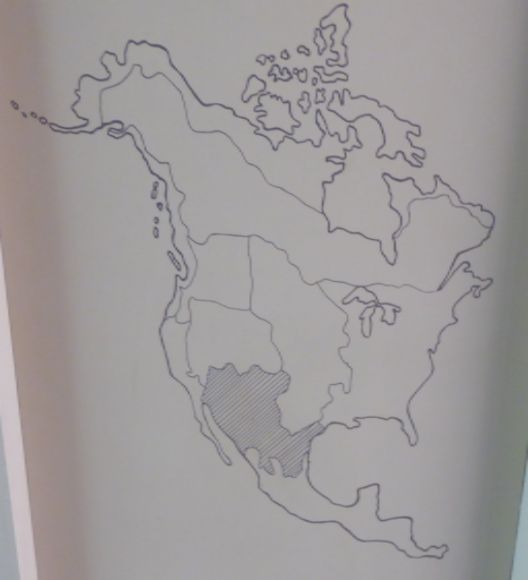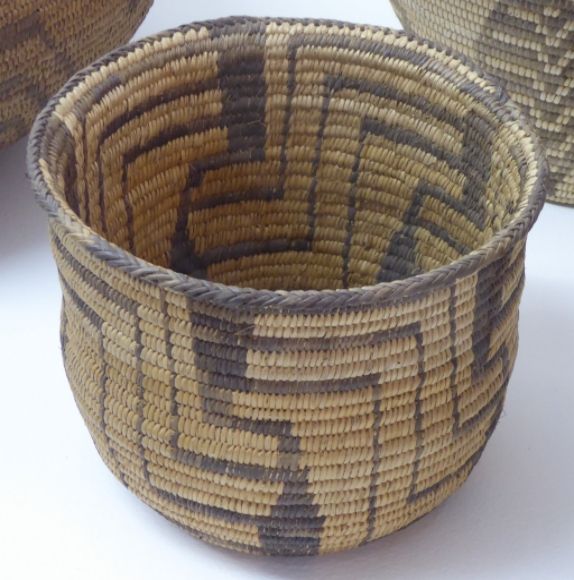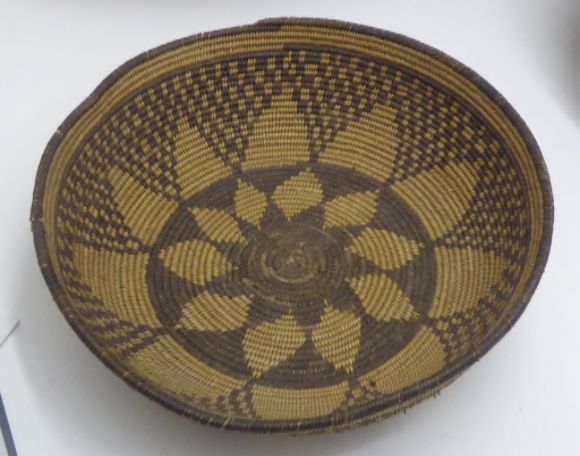The Southwest Culture Area is a culturally diverse area. Geographically it covers all of Arizona and New Mexico and includes parts of Colorado, Nevada, Utah, and Texas as well as parts of the Mexican states of Sonora and Chihuahua. Much of this area is semi-arid; part of it is true desert (southern Arizona); and part of it has upland and mountain ranges which support conifers.
 The shaded area on the map shown above shows the Southwest culture area.
The shaded area on the map shown above shows the Southwest culture area.
Throughout North American, Indian people made many different kinds of baskets from the available native materials.
With regard to basketry in the American Southwest, Jerold Collings, in his chapter in Harmony by Hand: Art of the Southwest Indians, writes:
“In the Southwest, native Americans have been producing baskets in a variety of forms and with considerable technical diversity for at least the past eight thousand years. Rigid and semirigid containers, mats, and bags—all played an important role in their early attempts to cope with a strikingly beautiful but often harsh environment.”
The transition from tribal art in which baskets are made for use by tribal members, to ethnic art in which baskets are made for sale to non-tribal members took place in the late nineteenth and early twentieth centuries. Arizona State Museum Assistant Curator Andrew Higgins, in an article in American Indian Art, writes:
“In the early 1900s, a tourist industry, spawned by railroad and automobile travel, and a nationwide basketry craze provided further impetus for Indian women to expand their basketry trade.”
Some of the Southwestern basketry on display in the Maryhill Museum of Art near Goldendale, Washington, is shown below.
O’odham
According to the Museum display:
“Akimel O’odham (Pima) and Tohono O’odham (Papago) baskets are very similar. Akimel O’odham weaving was historically the finer and more intricate of the two. Tohono O’odham baskets have large, somewhat flattened coils and bolder, less detailed designs. Geometric patterns—particularly arrangements of concentric lines—frequently appear. Representations of human beings, deer and other animals are also common. Bowls and trays were historic forms but other shapes were created for sale to outsiders.”




 Shown above is a Tohono O’odham “wine” bowl which was used for holding tiswin, a tradition ceremonial alcoholic drink made from the fruit of the saguaro cactus.
Shown above is a Tohono O’odham “wine” bowl which was used for holding tiswin, a tradition ceremonial alcoholic drink made from the fruit of the saguaro cactus.
 The figures on the Tohono O’odham basket shown above are gathering the fruit of the saguaro cactus.
The figures on the Tohono O’odham basket shown above are gathering the fruit of the saguaro cactus.



The beaded baskets shown above are Akimel O’odham.
Navajo Wedding Baskets
Navajo marriage ceremonies used baskets in which the bride’s father would set out containing mush for the couple to eat. According to the Museum display:
“The woven design is symbolic, representing human life. Life starts at the center and moves through the rain, which is represented by black and red cloud bands. The outer white band represents the increase of the Navajo people. The break in the design—the ‘trail’ or ‘doorway’—was oriented to the east during ceremonial use.”
These baskets were often made by Southern Paiute or Ute weavers.


Jicarilla Apache
The baskets shown below were made for sale to non-Indians. The elaborate looped rim and ring handles are an indication that the basket was made for the tourist trade.


Mescalero Apache
According to the Museum display:
“Among the Mescalero Apaches, coiled baskets were usually made with a two-rod or a bundle of sumac, sewn with split yucca. The white background was made from bleached yucca, while the green or yellow elements were made from unbleached portions of the plant. Red-brown accents utilized yucca roots. Geometric patterns and star shapes are common design elements.”




Western Apache
 The small burden basket on the left was made about 1900 and the one in the center was made in the late 1980s by Novena Cobb (San Carlos Apache).
The small burden basket on the left was made about 1900 and the one in the center was made in the late 1980s by Novena Cobb (San Carlos Apache).



 Shown above are water jars which have been coated with pitch. Water jars were generally twined from sumac or mulberry.
Shown above are water jars which have been coated with pitch. Water jars were generally twined from sumac or mulberry.
 The Western Apache basket in the shape of an olla shown above was made in the 1880s.
The Western Apache basket in the shape of an olla shown above was made in the 1880s.



 The entrance to the Maryhill Museum of Art is shown above.
The entrance to the Maryhill Museum of Art is shown above.


